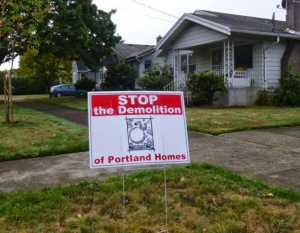 Three months after being tasked by the Portland City Council to propose modifications to the City’s demolition code, the Development Review Advisory Committee (DRAC) on Thursday endorsed a slate of recommendations that would affect how demolitions are conducted in Portland’s neighborhoods. The package of proposed code revisions—ranging from notification processes to defining ‘demolition’—is scheduled to go before the Portland City Council on December 17. Despite the best intentions of City staff and citizen committee members, the recommendations fall short of what many believe is needed to protect neighborhood landmarks from the recent wave of demolitions.
Three months after being tasked by the Portland City Council to propose modifications to the City’s demolition code, the Development Review Advisory Committee (DRAC) on Thursday endorsed a slate of recommendations that would affect how demolitions are conducted in Portland’s neighborhoods. The package of proposed code revisions—ranging from notification processes to defining ‘demolition’—is scheduled to go before the Portland City Council on December 17. Despite the best intentions of City staff and citizen committee members, the recommendations fall short of what many believe is needed to protect neighborhood landmarks from the recent wave of demolitions.
Restore Oregon intends to oppose a key provision of the DRAC recommendation that eliminates an important provision for demolition delay that has been on the books for 25 years.
How Did We Get Here?
In 2013, 279 Portland houses were demolished. In 2014 the number is likely to surpass 400. While demolitions aren’t a new phenomenon, the increasing number has raised the alarm of preservation and neighborhood advocates over the course of the past year. Restore Oregon has been active in the conversation and every local media outlet has covered the topic in recent months, making demolitions a topic du jour citywide. But to fully understand the current controversy, a refresher back to the Bud Clark years is necessary.
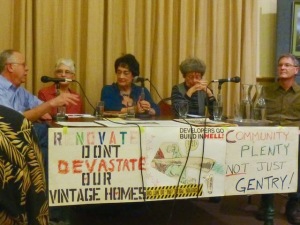
time demolition codes were debated in Portland (Photo:
United Neighborhoods for Reform)
In 1989, following a contentious battle to save homes in NW Portland, the City Council adopted a demolition delay ordinance. The basics of the code, 24.55.200, is that 35 days of delay and notification are required prior to a residential demolition with an additional 120-day extension available upon neighborhood association request. The code, however, provided a loophole for single-family home replacement projects, exempting “one-for-one” replacements from delay and notification. In 2013, approximately 43% of home demolitions were fast-tracked under this loophole. Dozens of additional demos have been able to skirt the rules because the 1989 code did not define “demolition,” an omission that has allowed builders to leave a small portion of an otherwise demolished structure and call it a “remodel.”
On July 31 of this year, the Portland City Council heard several hours of testimony from preservation advocates asking for improvements to the demolition code. Restore Oregon and a coalition of organizations called for the following three actions:
- Close loopholes by defining “demolition” as the removal of 50% or more of an existing building
- Require all residential demolitions to adhere to minimum delay and notification requirements
- Establish a taskforce to identify additional building and zoning code improvements that would ensure demolitions are appropriately managed and that replacement construction responds to neighborhood characteristics.
Following the July 31 meeting, the Council handed the task of reviewing the demolition code to the 17-member DRAC, a volunteer committee who “advocates for and supports consistent and fair application and implementation of regulations.” For the past three months, a subcommittee of DRAC has deliberated on the specific code changes that will be presented to Council. Restore Oregon, a small handful of neighborhood advocates, and staff from multiple City bureaus were invited to sit-in on the meetings without voting privileges.
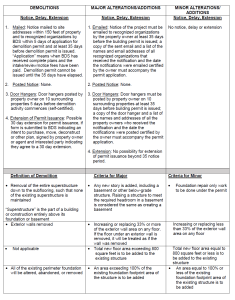
On November 20, DRAC endorsed a package of recommendations that will be considered by the City Council on December 17. Key provisions include:
-A 35-day delay for all residential demolitions.
-Expansion of neighborhood notification.
-Defining “demolition” narrowly as the complete removal of a structure.
-Creating a new category for “major alteration” that requires 35-day notification without opportunities for further delay.
-Eliminating the 120-day delay afforded to neighborhood associations, replacing it with a voluntary 30-day extension.
The Looming Fight Over the Demolition Code

Responding to the shortcomings of DRAC’s official proposal, two alternate proposals are expected to be presented to Council on the 17th.
First, a growing collation of neighborhoods are rallying behind the efforts of the United Neighborhoods for Reform, an ad hoc organization that has proposed code changes consistent with Restore Oregon’s recommendations to City Council. Several thousand people and over a dozen neighborhood associations have signed on to support the proposal. Key provisions of the resolution include:
-In addition to the automatic 35-day delay, provide neighborhood associations with a 120-day delay extension option.
-Defining demolition as removal of more than 50% of a building.
-Documenting compliance with applicable environmental and hazardous materials regulations.
Second, following the rejection of a “deconstruction” proposal at an earlier DRAC subcommittee meeting, a group of salvage stakeholders have proposed adding a process for deconstruction projects. While DRAC has agreed to take up the proposal in 2015, environmental advocates plan to take the following provisions to Council next month:
-Adding code definitions for “deconstruction” and “relocation.”
-Affording deconstructions and relocations shorter delay and notification periods than demolitions in cases where the neighborhood association agrees in advance to fast-track the project.
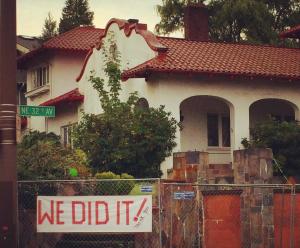
additional time needed for grassroots advocacy
While appreciating the thankless efforts of both City staff and DRAC volunteers, the narrow definition of demolition and, especially, the complete removal of the delay extension largely negate the positives of the package in terms of historic preservation objectives.
Under DRAC’s proposed changes, neighborhood associations will lose the ability to extend delay on hundreds of properties a year. This means properties like the Markham House may be lost before a grassroot effort can take hold. When weighed against current code language and the demolition statistics, DRAC’s proposed changes for delay and notification represent one step forward and one step backward.
What’s Next?
Last month Corvallis passed new demolition regulations requiring a 50-day delay and agreement that houses be offered for sale or relocation before they are razed, demonstrating that more aggressive demolition requirements can be politically palatable in Oregon. While compromises in Portland will have to be reached, the December 17th 3:30pm Council hearing will be an important one for preservationists and neighborhood residents.
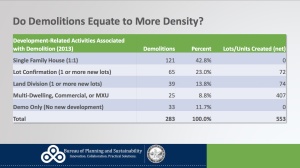
in greater density and 57% are afforded the option of a 120
day demolition delay extension, a provision that would go
away under the DRAC recommendation
Most agree the end solution to the demolition crisis will be a balancing act that encourages good development and discourages the loss of viable housing stock. Because the code doesn’t address the demolition of commercial structures, most of the demolitions that provide the greatest density bang for the buck are unaffected by this process, making the upcoming Council hearing more about neighborhood livability than about the urban growth boundary. Restore Oregon remains optimistic that a positive outcome will emerge from the meeting.
We’ll see you there!
Author’s note: Any comment that defames individual City staff or DRAC members will be banned from this post.


One Reply to “Recommendations to Address Demolition Epidemic Now Headed to Council”
Comments are closed.